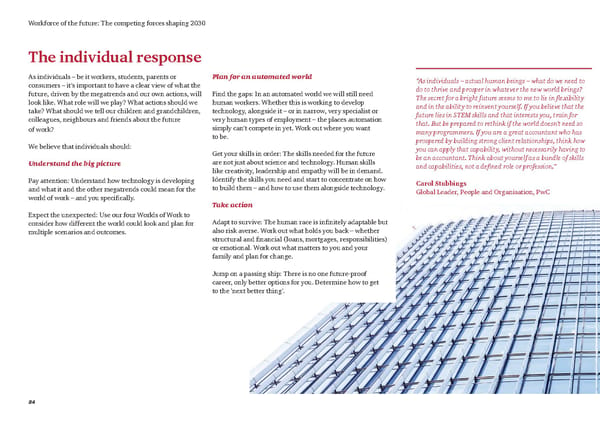34 Workforce of the future: The competing forces shaping 2030 The individual response “As individuals – actual human beings – what do we need to do to thrive and prosper in whatever the new world brings? The secret for a bright future seems to me to lie in flexibility and in the ability to reinvent yourself. If you believe that the future lies in STEM skills and that interests you, train for that. But be prepared to rethink if the world doesn’t need so many programmers. If you are a great accountant who has prospered by building strong client relationships, think how you can apply that capability, without necessarily having to be an accountant. Think about yourself as a bundle of skills and capabilities, not a defined role or profession.” Carol Stubbings Global Leader, People and Organisation, PwC As individuals – be it workers, students, parents or consumers – it’s important to have a clear view of what the future, driven by the megatrends and our own actions, will look like. What role will we play? What actions should we take? What should we tell our children and grandchildren, colleagues, neighbours and friends about the future of work? We believe that individuals should: Understand the big picture Pay attention: Understand how technology is developing and what it and the other megatrends could mean for the world of work – and you specifically. Expect the unexpected: Use our four Worlds of Work to consider how different the world could look and plan for multiple scenarios and outcomes. Plan for an automated world Find the gaps: In an automated world we will still need human workers. Whether this is working to develop technology, alongside it – or in narrow, very specialist or very human types of employment – the places automation simply can’t compete in yet. Work out where you want to be. Get your skills in order: The skills needed for the future are not just about science and technology. Human skills like creativity, leadership and empathy will be in demand. Identify the skills you need and start to concentrate on how to build them – and how to use them alongside technology. Take action Adapt to survive: The human race is infinitely adaptable but also risk averse. Work out what holds you back – whether structural and financial (loans, mortgages, responsibilities) or emotional. Work out what matters to you and your family and plan for change. Jump on a passing ship: There is no one future ‑ proof career, only better options for you. Determine how to get to the ‘next better thing’.
 Workforce of the future Page 33 Page 35
Workforce of the future Page 33 Page 35